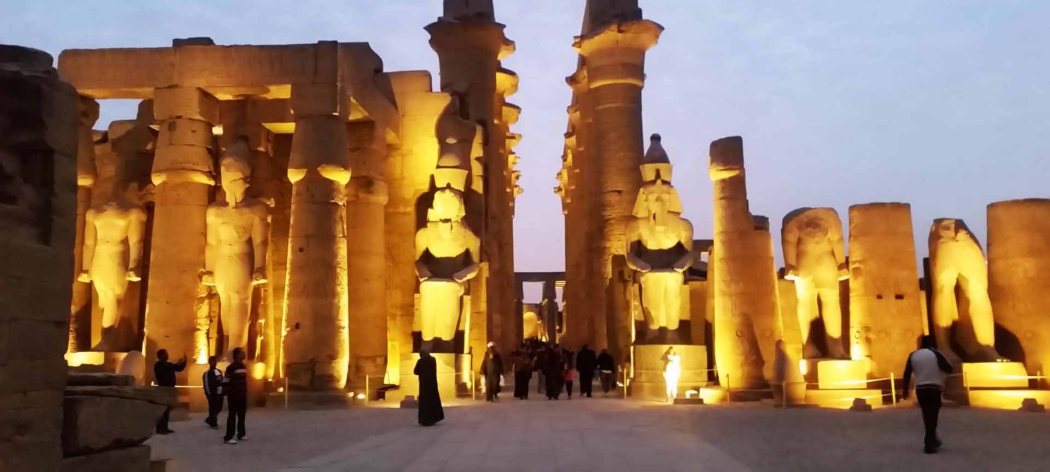Luxor is a city in Upper Egypt on the site of the ancient Egyptian city, Thebes, and Luxor is characterized by having the largest open-air museum in the world and is also famous for being one of the most important tourists and archeological cities in the world.
A brief history of Luxor
Luxor was the ancient city of Thebes, the capital of Upper Egypt during the era of the modern state, and it was the glorious city of Amun, which later became the god Amon Ra, and the city was known in ancient Egyptian texts as the city of the scepter, and in a later period the Greeks called it Tibi, then the Romans called it good The city of Thebes was known as the City of the Hundred Gates, and sometimes south of Heliopolis, to distinguish it from the city of Heliopolis, which was the main center for the worship of God Ra in the north.
The importance of the city of Thebes began to appear during the reign of the eleventh family when it grew as a prosperous city through the Egyptian Nubian race and was famous for its high social status and luxury, as well as a center of wisdom, art, religion, and political superiority, and Muntotep the second brought stability to Radi after the unification of Egypt After the troubles of the first intermediate period, the city grew more then, and Thebes played a large role in expelling invading forces such as the Hyksos from Upper Egypt, and from the time of the eighteenth century until the Twentieth Dynasty the city flourished as a major religious, political, and military capital of ancient Egypt.
Luxor city site
Luxor is located in the south of Egypt, with an area of about 416 square kilometers.
There are many places to visit in Luxor such as:
Karnak Temple
The Karnak Temple and the Known in the name of Karnak includes a huge mixture of chapels, temples, towers and other buildings, and the construction of the temple began during the reign of Senusert I in the Middle Kingdom and continued until the Ptolemaic period, the Karnak Temple is considered the second largest ancient religious site in the world after Angkor Wat temple in Cambodia, and the temple consists of four main parts open to the public.
Valley of the Kings
The Valley of the Kings or Valley of the King's Gate is a valley in Egypt where cemeteries were built for the pharaohs and nobles of the modern state for nearly 500 years from the sixteenth century B.C. to the eleventh century B.C., and the valley is located on the west bank of the Nile, opposite to Thebes in the heart of a cemetery Thebes, and the Valley of the Kings is composed of two valleys, the eastern valley where most of the royal tombs and the western valley.
Memnon Giants
The Giants of Memnon are the huge stone statues of Pharaoh Amenhotep the Third who ruled during the eighteenth dynasty, over 3400 years ago. The Giants were located in the necropolis west of the Nile from Luxor, and the twin statues represent a depiction of Amenhotep III in a sitting position with his hands resting on his knees His eyesight is directed east towards the Nile, and the statues have suffered some damage over time.
Deir el-Bahari
Deir el-Bahari is a complex of funerary temples and cemeteries located on the west bank of the Nile River, opposite the city of Luxor, and is part of the Theban Cemetery. Birth, and during the period of the eighteenth dynasty Amenithet I and Hatshepsut built the site on a large scale.
The city of Habo
The funerary temple in the city of Habo is a very important structure dating back to the era of the modern state and is located on the west bank of Luxor, regardless of its size and artistic architectural importance, and the temple is perhaps the best-known source of inscriptions that show the defeat of peoples during the reign of Ramses III, and The length of the temple to about 150 meters, which is designed by the Orthodox, and is similar to the funerary temple of Ramses II and is the Temple of Ramsium.
Luxor temple
Luxor Temple is a large ancient Egyptian temple located on the eastern bank of the Nile River in Luxor today and it was founded in 1400 BC, and the Egyptian language is known as Abit or the southern sanctuary, and there are many great temples on the eastern and western banks, and are considered the main temples They are the Four Temple of Seti I, the Hatshepsut Temple, Deir el Bahari, and the Ramsium Temple.
Valley of the Queens
The Valley of the Queens is a place in Egypt where the wives of the Pharaohs were buried in ancient times and was known in ancient times as the ta-set-never which means the place of beauty, and the valley consists of the main place that contains most of the graves, and also the valley of Prince Ahmose The Valley of Robe, the Valley of the Three Pits, and the Valley of the Dolomites, and the main valley contains 91 cemeteries and 19 other sub-valley.

 Arabic
Arabic English
English Chinese
Chinese

